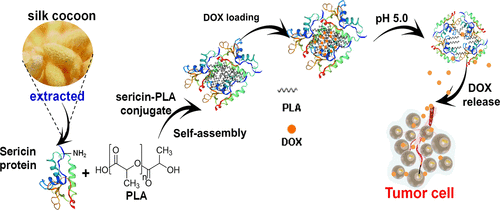当前位置:
X-MOL 学术
›
Bioconjugate Chem.
›
论文详情
Our official English website, www.x-mol.net, welcomes your
feedback! (Note: you will need to create a separate account there.)
Silk Sericin-Polylactide Protein-Polymer Conjugates as Biodegradable Amphiphilic Material and Its Application in Drug Release Systems.
Bioconjugate Chemistry ( IF 4.0 ) Pub Date : 2020-09-14 , DOI: 10.1021/acs.bioconjchem.0c00399 Kanittha Boonpavanitchakul 1 , Livia K Bast 2, 3 , Nico Bruns 2, 3 , Rathanawan Magaraphan 1, 4, 5
Bioconjugate Chemistry ( IF 4.0 ) Pub Date : 2020-09-14 , DOI: 10.1021/acs.bioconjchem.0c00399 Kanittha Boonpavanitchakul 1 , Livia K Bast 2, 3 , Nico Bruns 2, 3 , Rathanawan Magaraphan 1, 4, 5
Affiliation

|
Silk sericin (SS) is a byproduct of silk production. In order to transform it into value-added products, sericin can be used as a biodegradable and pH-responsive building block in drug delivery materials. To this end, amphiphilic substances were synthesized via the conjugation of hydrophobic polylactide (PLA) to the hydrophilic sericin using a bis-aryl hydrazone linker. PLA was esterified with a terephthalaldehydic acid to obtain aromatic aldehyde terminated PLA (PLA-CHO). In addition, lysine groups of SS were modified with the linker succinimidyl-6-hydrazino-nicotinamide (S-HyNic). Then, both macromolecules were mixed to form the amphipilic protein–polymer conjugate in buffer–DMF solution. The formation of bis-aryl hydrazone linkages was confirmed and quantified by UV–vis spectroscopy. SS-PLA conjugates self-assembled in water into spherical multicompartment micelles with a diameter of around 100 nm. Doxorubicin (DOX) was selected as a model drug for studying the pH-dependent drug release from SS-PLA nanoparticles. The release rate of the encapsulated drug was slower than that of the free drug and dependent on pH, faster at pH 5.0, and it resulted in a larger cumulative amount of drug released than at physiological pH of 7.4. The SS-PLA conjugate of high PLA branches showed smaller particle size and lower loading capacity than the one with low PLA branches. Both SS-PLA conjugates had negligible cytotoxicity, whereas after loading with DOX, the SS-PLA micelles were highly toxic for the human liver carcinoma immortalized cell line HepG2. Therefore, the SS-based biodegradable amphiphilic material showed great potential as a drug carrier for cancer therapy.
中文翻译:

蚕丝丝胶蛋白-聚乳酸蛋白质-聚合物结合物为可生物降解的两亲材料,在药物释放系统中的应用。
丝胶(SS)是丝绸生产的副产品。为了将其转化为增值产品,丝胶可以用作药物输送材料中可生物降解和pH响应的构件。为此,使用双芳基连接基通过疏水性聚丙交酯(PLA)与亲水性丝胶的缀合来合成两亲性物质。用对苯二酸将PLA酯化,得到芳香醛封端的PLA(PLA-CHO)。另外,SS的赖氨酸基团被接头琥珀酰亚胺-6-肼基-烟酰胺(S-HyNic)修饰。然后,将两种大分子混合,在缓冲液-DMF溶液中形成两亲性蛋白质-聚合物共轭物。通过紫外可见光谱法确认并量化了双芳基hydr键的形成。SS-PLA缀合物在水中自组装成直径约100 nm的球形多室胶束。选择阿霉素(DOX)作为模型药物,用于研究SS-PLA纳米颗粒的pH依赖性药物释放。包封的药物的释放速率比游离药物的释放速率慢,并且取决于pH,在pH 5.0时更快,并且与在生理pH 7.4时相比,释放的累积药物量更大。高PLA分支的SS-PLA共轭物比低PLA分支的SS-PLA共轭物具有更小的粒径和更低的负载能力。两种SS-PLA缀合物的细胞毒性均可以忽略不计,而在加入DOX后,SS-PLA胶束对人类肝癌永生化细胞系HepG2具有高毒性。因此,
更新日期:2020-10-21
中文翻译:

蚕丝丝胶蛋白-聚乳酸蛋白质-聚合物结合物为可生物降解的两亲材料,在药物释放系统中的应用。
丝胶(SS)是丝绸生产的副产品。为了将其转化为增值产品,丝胶可以用作药物输送材料中可生物降解和pH响应的构件。为此,使用双芳基连接基通过疏水性聚丙交酯(PLA)与亲水性丝胶的缀合来合成两亲性物质。用对苯二酸将PLA酯化,得到芳香醛封端的PLA(PLA-CHO)。另外,SS的赖氨酸基团被接头琥珀酰亚胺-6-肼基-烟酰胺(S-HyNic)修饰。然后,将两种大分子混合,在缓冲液-DMF溶液中形成两亲性蛋白质-聚合物共轭物。通过紫外可见光谱法确认并量化了双芳基hydr键的形成。SS-PLA缀合物在水中自组装成直径约100 nm的球形多室胶束。选择阿霉素(DOX)作为模型药物,用于研究SS-PLA纳米颗粒的pH依赖性药物释放。包封的药物的释放速率比游离药物的释放速率慢,并且取决于pH,在pH 5.0时更快,并且与在生理pH 7.4时相比,释放的累积药物量更大。高PLA分支的SS-PLA共轭物比低PLA分支的SS-PLA共轭物具有更小的粒径和更低的负载能力。两种SS-PLA缀合物的细胞毒性均可以忽略不计,而在加入DOX后,SS-PLA胶束对人类肝癌永生化细胞系HepG2具有高毒性。因此,











































 京公网安备 11010802027423号
京公网安备 11010802027423号